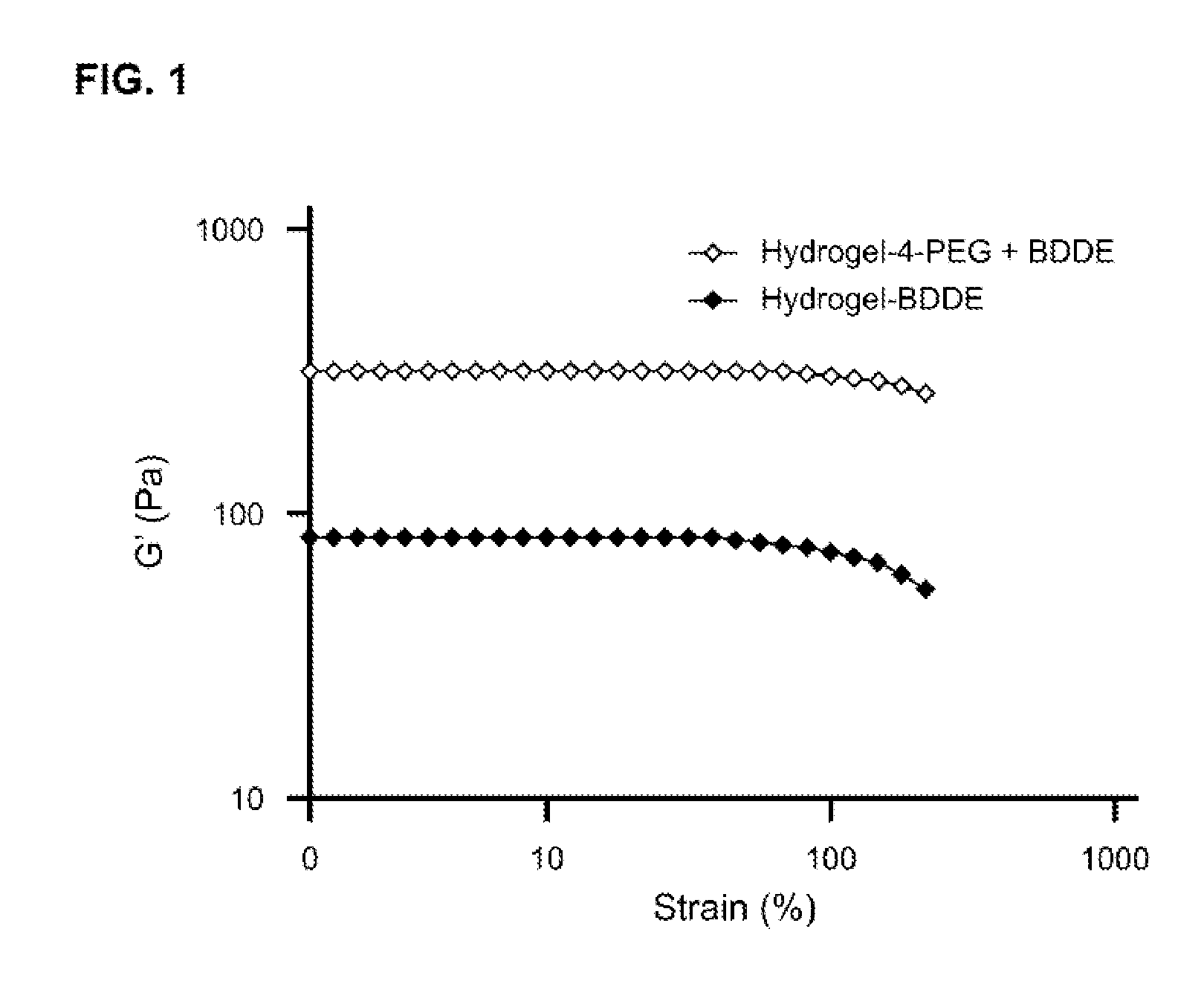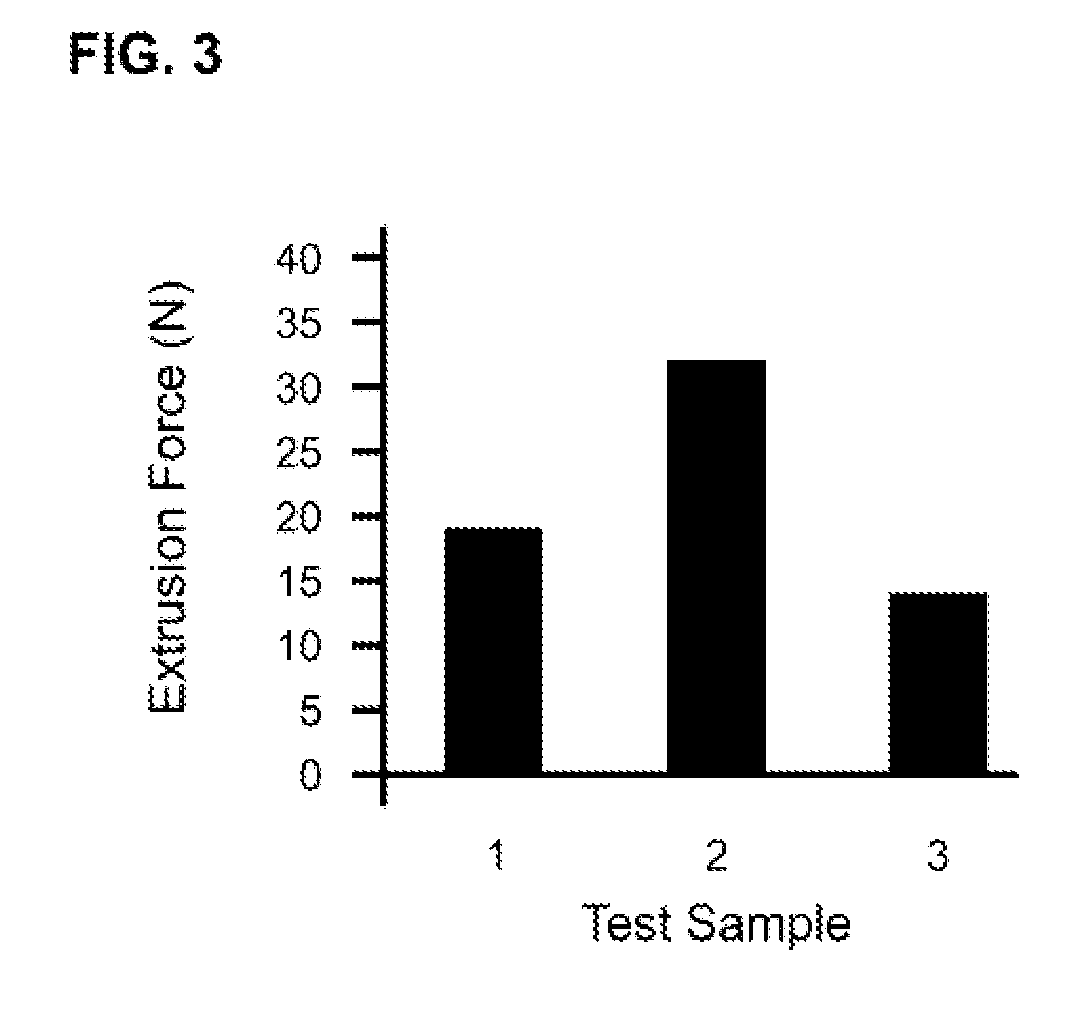Tunably Crosslinked Polysaccharide Compositions
a polysaccharide and composition technology, applied in the field of uniformly crosslinked polysaccharide compositions, can solve the problems of increasing the rate of degradation of hyaluronan, affecting the quality of dermal fillers, and requiring fairly frequent reinjection, so as to improve an aspect of soft tissue condition and eliminate a symptom of soft tissue condition
- Summary
- Abstract
- Description
- Claims
- Application Information
AI Technical Summary
Problems solved by technology
Method used
Image
Examples
example 1
Synthesis of a Multifunctional PEG-Based Crosslinking Agent
[0116]This example illustrates how to make a multifunctional PEG-based crosslinking agent as disclosed herein from a base polyalcohol.
[0117]A multifunctional PEG-based crosslinking agent disclosed herein can be synthesized using a general scheme below. A base polyalchohol of about 200 Da to about 10,000 Da, and having the desired length and branching, is initially reacted with sodium hydride or any other reagent that can deprotonate the hydroxyl groups and then with epichlorohydrin or any other appropriate epoxide group(s). In the schematic below, a 4-arm base alcohol is shown; where n may be an integer of 0 to 60. In addition, although the general chemical schematic is illustrated with a 4-arm base polyalchohol, a similar synthesis scheme is employed to produce other multifunctional PEG-based crosslinking agents by simply using the appropriate base polyalcohol. For example, to synthesize a bifunctional PEG-based crosslinker...
example 2
Crosslinking of Glycosaminoglycan Polymers Using Multifunctional PEG-Based Crosslinker
[0119]This example illustrates how to crosslink glycosaminoglycan polymers using a multifunctional PEG-based crosslinking agent as disclosed herein.
[0120]To crosslink glycosaminoglycan polymers using a multifunctional PEG-based crosslinker, 400 mg of low molecular weight sodium hyaluronate, such as, e.g., about 400,000 Da, was mixed with 2.3 grams of 1% sodium hydroxide solution and hydrated by incubating at ambient temperature for about 30 minutes. Alternatively, a high molecular weight sodium hyaluronate, such as, e.g., about 2,000,000 Da can be used. After hydration, about 80 mg (20% w / w) of a tetrafunctional PEG-based crosslinking agent of Example 1 (about 360 Da) was added to the hydrated sodium hyaluronate. The mixture was then mechanically homogenized, and then placed in an about 50° C. oven for about 90 minutes. The resulting crosslinked hydrogel is neutralized with an equimolar amount of h...
example 3
Sizing Hydrogel Comprising Crosslinked Glycosaminoglycan Polymers
[0123]This example illustrates how to process a hydrogel composition into particles.
[0124]To size a hydrogel comprising crosslinked glycosaminoglycan polymers, the resulting hydrogel comprising crosslinked hyaluronan polymers of Example 2 was processed once through a 60 μm mesh screen. The sized hydrogel particles were then dialyzed for one week using a 20 kDa MWCO bag. The dialyzed hydrogel was then transferred to 0.8 mL syringe and flash sterilized at 128° C.
[0125]Alternatively, the resulting hydrogel comprising crosslinked hyaluronan polymers of Example 2 was processed once through a 25 μm or a 43 μm mesh screen. The sized hydrogel particles were then dialyzed for one week using a 20 kDa MWCO bag. The dialyzed hydrogel was then transferred to 0.8 mL syringe and flash sterilized at 128° C.
[0126]To size a hydrogel comprising crosslinked glycosaminoglycan polymers, the resulting hydrogel comprising crosslinked hyaluron...
PUM
| Property | Measurement | Unit |
|---|---|---|
| concentration | aaaaa | aaaaa |
| concentration | aaaaa | aaaaa |
| concentration | aaaaa | aaaaa |
Abstract
Description
Claims
Application Information
 Login to View More
Login to View More - R&D
- Intellectual Property
- Life Sciences
- Materials
- Tech Scout
- Unparalleled Data Quality
- Higher Quality Content
- 60% Fewer Hallucinations
Browse by: Latest US Patents, China's latest patents, Technical Efficacy Thesaurus, Application Domain, Technology Topic, Popular Technical Reports.
© 2025 PatSnap. All rights reserved.Legal|Privacy policy|Modern Slavery Act Transparency Statement|Sitemap|About US| Contact US: help@patsnap.com



